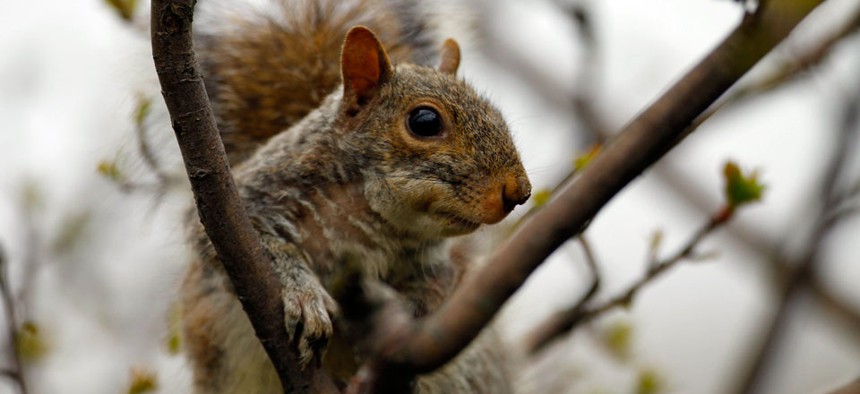
A squirrel sits in one of the Tulip Magnolia trees in the Rose Garden of the White House. Alex Brandon/AP File Photo
The Government's Surprising History of Squirrel Population Engineering
One man's mission to stock the National Mall with 'interesting little animals.'
The National Mall needed squirrels.
The year was 1899, and with the Civil War fading with the memory of an older generation, the state of Virginia offered a great gift to the nation's capital—a pair of squirrels. But not just any squirrels. These woodland creatures were poised to become the Adam and Eve of all the squirrels that now populate the National Mall.
At the turn of the 20th century, squirrels were mysteriously missing from the capital city. And Elliot Woods, then head of the office of the Architect of the Capitol, felt their absence and sought to restock the mall. Sometime earlier in 1899, he had penned a letter to the register of the Land Office of Virginia, requesting a pair of the furry rodents.
"I hope to be able to confer a like footy ... game early this fall. I would have to have a cage to express this in," W. Richardson, a Virginia bureaucrat, wrote back to Woods in August.
In 1901, news of the deal went public. "Several Pairs of Interesting Little Animals to Be Set Free Among the Trees," read the subhead of the scoop inThe Washington Post. "It is [Wood's] intention to stock the grounds surrounding the Capitol Buildings with squirrels, in order to increase the attractiveness of the park. Several pairs will be set at liberty within the next few weeks, and it is expected that the little fellows will soon make themselves home in the big trees."
Wood's only fear was "that the small boys would annoy the animals, and perhaps kill them before they have a chance to propagate." Woods called on the public to aid in protecting the animals from the more vicious children. One can envision Elliot Wood's gravestone inscribed with the words: "Great Squirrel Liberator." But that's not the case.
"In a comparatively short time," The Post continued, "the animals will multiply and become a source of amusement to the numerous children who run and play on the grass under the trees."
But how is it possible that, at that time, squirrels roamed Virginia but not right across the Potomac, in Washington? A 2008 feature in The Post claims the native squirrel population had been wiped out due to hunting. But I wanted to confirm with an expert.
John L. Koprowski is a professor at the University of Arizona. I found him via Wikipedia, where he is identified as a "leading expert on the ecology and conservation of squirrels." And my confidence in his expertise was assured when I discovered that his email address included the word "squirrel."
"Pretty amazing critters," he wrote to me from China. He thinks urban development was partially to blame for the silence of the squirrels. "Eastern gray squirrels prefer relatively closed forest and don't typically do well in very open forests, such as prairie edges or urban areas that have been cleared," he wrote. "I would hazard a guess that the trees of the Capitol area were cleared and young (not producing much seed); thus, it was a suboptimal habitat."
During that time, he informs me, "great squirrel migrations were common" as forests were cleared. But fondness for the little beast had not waned. "Such augmentations and translocations were incredibly common during the 1800s and 1900s as many wanted to bring a bit of home with them."
Whatever the reason for the great squirrel dearth, it appears Wood's campaign worked. In 1903, the mall was teeming with squirrels, so much so that concerns grew there would not be enough shelter for them in the cold winter months (never mind the fact that squirrels are hardy enough to shrug off the cold). A concerned Treasury Department employee wrote Woods: "It may not have occurred to you that my little friends the squirrels in the Capitol grounds may possibly be short of houses for the approaching winter," the letter reads. "They have increased considerably in number, and may suffer if they are not provided for."
Not everyone in the District was happy with the change in fauna, however. "It is a fact that the squirrels in the Capitol grounds, while somewhat amusing, are nevertheless a nuisance in several respects," a resident named H.B. Dodges wrote. Aside from the squirrels' habit of driving birds away, "by robbing their nests," the rodents had reportedly been stealing nuts from the homeowner's walnut tree. "They are about the place nearly every day and on Thanksgiving Day, one of them sat on my porch railing and looked at me as I sat at my desk, as imprudent as anything could be, as much as to say, how can you help yourself! I don't want to kill or injure them, but I must protest myself in some way." Or, as we would say today, Dodges felt that the squirrel was indicating the homeowner should "come at me, bro."
The government, it turns out, has had a heavy hand in D.C. squirrel population engineering. The Capitol's black squirrels were brought here from Canada, according to a 2011 article in The Post. The U.S. sent some gray squirrels to its northern neighbor in exchange for the black squirrels, which arrived at the National Zoo in 1902.
Squirrel exchanges, however, do not always work out for the best, Koprowski explains. "Washington, D.C.'s squirrels are believed to be one of the sources of Italy's introduced eastern gray squirrels that are quite problematic," he said. According to Scientific American, four gray squirrels were a gift from a U.S. ambassador. But, "they escaped and have been expanding their territory exponentially ever since."







